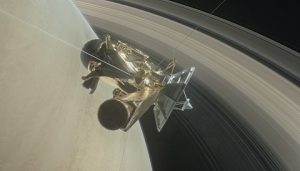Analyses of data from Cassini’s final days suggest the rings are a late addition and use them to solve a Saturnian mystery.

If the early dinosaurs had star parties, they probably weren’t impressed by Saturn. Based on data from the Cassini spacecraft’s last hurrah, planetary scientists strongly suspect that the iconic hula-hoop of icy particles encircling Saturn is a relatively new addition.
Astronomers have made this suggestion before, but with various hesitations. What they really needed was a good grasp of how much stuff the rings contain, as well as how quickly they’re being darkened by infalling space debris. These bits of information would indicate how long the rings could survive in their current, icy-bright state.
Cassini provided a unique opportunity to test the hypothesis. As the spacecraft’s gas gauge sank toward empty, mission planners rerouted the orbiter to take 22 daredevil dives between the planet and its rings. As it passed through, the spacecraft felt the gravitational tug of both the planet and the rings. Luciano Iess (Sapienza University of Rome) and colleagues undertook a complex analysis of these dives, teasing out the rings’ contribution from the planet’s.
Reporting January 17th in the journal Science, the team concludes that the rings have a mass of 15 million trillion kilograms (1.5 x 1019 kg), roughly 40% that of Saturn’s mid-size moon Mimas or about a millionth of Earth’s mass. Other Cassini data also indicate that some 10 times more space dust is raining down on the rings than expected, meaning they can’t be excessively old and look as bright as they do. Combined with other measurements, the observations support an age for the rings of roughly 10 million to 100 million years, favoring the higher end of that range. Previous work suggests that the rings won’t last forever, either — maybe another couple hundred million years.
The upper end of the age range echoes that previously suggested for several of Saturn’s mid-size icy moons. Some planetary scientists think these satellites formed from the rubble of a previous generation of moons, which smashed into one another and obliterated. How that event and the current ring system might be connected remains unclear, however: It’s hard to understand why the detritus that makes up the rings would have migrated so close to the planet instead of clumping together into additional moons farther out, the team notes in the paper. One alternate idea is that Saturn caught a passing comet or icy asteroid and tore it apart, then festooned itself in the wreckage.
In a separate study, graduate student Christopher Mankovich (University of California, Santa Cruz) used the rings to answer a decades-long question: How long is Saturn’s day?
Astronomers can determine the duration of Jupiter’s day based on a periodic radio signal, created as Jupiter twirls around by the planet’s mismatched rotational and magnetic axes. But Saturn’s magnetic field is almost perfectly aligned with its rotation axis.
Instead, Mankovich and his colleagues used Saturn’s rings as a sort of seismometer. Vibrations within the planet cause shifts in its gravitational field, and these create wave patterns in the rings. The patterns’ speeds in turn reveal how fast the planet is rotating: 10 hours, 33 minutes, and 38 seconds. This estimate is nearly 6 minutes shorter (and far more solid) than one based on Voyager data. The results appear in the January 20th Astrophysical Journal.
Read more about the rings’ age in press releases from NASA JPL and University of California, Berkeley. You can find more about the day measurement in releases from University of California, Santa Cruz, and NASA JPL.
References:
Luciano Iess et al. “Measurement and Implications of Saturn’s Gravity Field and Ring Mass.” Science. January 17, 2019.
Christopher Mankovich et al. "Cassini Ring Seismology as a Probe of Saturn's Interior. I. Rigid Rotation." Astrophysical Journal. January 20, 2019. Full preprint text here.
 0
0









Comments
You must be logged in to post a comment.